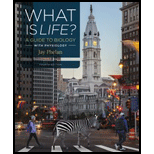
What Is Life? A Guide to Biology with Physiology
4th Edition
ISBN: 9781319065447
Author: Jay Phelan
Publisher: W. H. Freeman
expand_more
expand_more
format_list_bulleted
Concept explainers
Question
Chapter 2, Problem 3MC
Summary Introduction
Introduction:
Covalent bonds are formed by the sharing of electrons.
Expert Solution & Answer
Want to see the full answer?
Check out a sample textbook solution
Students have asked these similar questions
All of the following are considered “weak” interactions in proteins, except:
a. hydrogen bonds.
b. hydrophobic interactions.
c. ionic bonds.
d. peptide bonds.
e. van der Waals forces.
This type of noncovalent bond is responsible for clustering fatty acid tails of phospholipids in a micelle.
a. Disulfide bonds
b. Hydrogen bonds
c. Hydrophobic interactions
d. Ionic interactions
e. van der Waals interactions
Rank the following chemical bonds in order of increasing polarity.a. nonpolar covalent b. ionic c. polar covalent
Chapter 2 Solutions
What Is Life? A Guide to Biology with Physiology
Knowledge Booster
Learn more about
Need a deep-dive on the concept behind this application? Look no further. Learn more about this topic, biology and related others by exploring similar questions and additional content below.Similar questions
- . A cation is a(n)a. uncharged atom.b. positively charged atom.c. negatively charged atom.d. atom that has gained an electronarrow_forwardThe ability of non-polar substances like fat molecules to clump together in water thereby allowing minimal contact between the fat molecules and water is attributed to: Group of answer choices a. Hydrogen bonds b. Ionic bonds c. Van der Waal’s interactions d. Hydrophobic interactions e. Cystine bridgesarrow_forwardThis occurs when the cations and anions are attracted to the positive and negative ends of water molecules: A. ionic bonding B. dissociation C. covalent bonding D. hydrogen bondingarrow_forward
- Looking at the two different types of molecules (glycerol and fatty acids), describe the molecules with respect to: a. Polarity b. Acidityarrow_forwardWhich of the following bonding types is the most important in the nonaqueous interfaces between protein subunits? a. van der Waals interactions b. the hydrophobic effect c. ionic bonds d. disulfide bridgesarrow_forward.Amino acids a. have high dipole moments. b. are weak acids. c. with high molecular masses will be insoluble in water. d. are weak bases. Which statement is false?arrow_forward
- The mutual attraction of opposite charges holds atoms together as molecules in an _______ bond. a. ionic c. polar covalent b. hydrogen d. nonpolar covalentarrow_forwardOne of the results of a fat being saturated is that the molecules interact stronger. This means that saturated fats are usually solid at room temperature while unsaturated fats are typically liquids. The interactions between triglycerides falls under which of the following types. Select one: a. Covalent Bonds b. van der Walls bonds c. Hydrogen Bonds d. Ionic Bondsarrow_forwardA (-) charge in the transition state can be stabilized by a catalyst, which is usually a(n): a. Anion b. Base Oc. Nucleophile Od. Acidarrow_forward
- Define the following terms: a. phospholipids b. soap c. surface active agent d. phosphoglyceride e. sphingomyelinarrow_forwardThe “octet rule” in chemistry helps predict the types of bonds thatatoms will form. In general, an atom will be most stable if it fills itsouter shell of 8 electrons. Atoms with fewer than 4 valence electronstend to donate electrons and those with more than 4 valence electronstend to accept additional electrons; those with exactly 4 can do both.Using this rule, determine what category each of the followingelements falls into: N, S, C, P, O, H, Ca, Fe, and Mg. (You will needto work out the valence of the atoms.)arrow_forwardThe salt of diclofenac, a nonsteroidal anti-inflammatory drug (NSAID), has a chemical formula NaC14H10C2NO2. The structure of this drug is provided below. When dissolved in water, it produces: Na + H 'N. CI Select one: a. An acidic solution b. A basic solution C. A neutral solution d. Not enough information is provided. O OOarrow_forward
arrow_back_ios
SEE MORE QUESTIONS
arrow_forward_ios
Recommended textbooks for you

Macromolecules | Classes and Functions; Author: 2 Minute Classroom;https://www.youtube.com/watch?v=V5hhrDFo8Vk;License: Standard youtube license